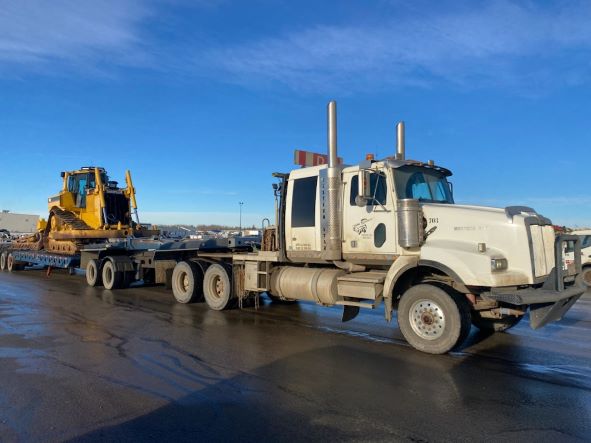Back in March, an excavator collision in Calgary stirred up a conversation about prioritizing safety when hauling heavy equipment.
The collision, which occurred when a truck driver hauling an excavator crashed into the side of an overpass, was avoidable–however, the truck driver did not take proper precautions to ensure that the load reached its destination safely.
In this article, we’ll take a look at the incident itself and how it could have been avoided. Plus, we’ll teach you some essential lessons in heavy haul transport so you never end up in the same situation as this driver.
The Excavator Accident
At around 9:30 a.m. on March 23rd, 2023, a semi-truck hauling an excavator crashed into the underside of the 32nd Avenue overpass in Calgary. This resulted in the temporary closure of two lanes of southbound traffic on Deerfoot Trail, significantly slowing traffic and forcing motorists to find alternate routes to their destinations.
No injuries were reported, but the collision left chunks of concrete scattered around Deerfoot Trail, threatening public safety. In addition to the closed lanes on Deerfoot, the 32nd Avenue overpass was also closed due to concerns about the overpass’s structural integrity.
Fortunately, engineers determined that the structural damage was not dangerous and the overpass was safe to cross. The overpass and the southbound lanes of Deerfoot Trail were reopened by 5 a.m. the next morning.
The commercial truck driver who caused the accident has been charged with careless driving and operation of a commercial vehicle in a prohibited manner. This incident would not have occurred if the driver had taken the proper precautions. However, it does provide a great learning opportunity!
Lessons Learned
The primary reason for this crash was that the excavator being transported was too tall for the 32nd Avenue overpass. It isn’t clear why the heavy haul driver did not realize that the excavator was too tall, but we can certainly speculate on the potential reasons.
The collision may have occurred because the measurements of the equipment were not accurate. Perhaps the driver did not have the correct height specifications of the excavator and thought that it would fit under the overpass.
Another potential reason for the crash is that the driver may not have mapped the route beforehand. If he had, he likely would have realized that his heavy load was too tall for the overpass, and he would have selected an alternate route. Mapping routes is critical for this exact reason.
The collision also implies that the driver may not have had the proper permit. Excavators are tall machines, and so they often count as oversized loads–something which drivers require a permit to transport. If the driver had a permit, he would also need to abide by route regulations designed to avoid situations just like this!
The Basics of Heavy Hauling
Before you start transporting heavy equipment, it is absolutely critical that you are aware of the basics of heavy hauling. Without research and ample preparation, hauling heavy equipment is incredibly dangerous for you and all other drivers. Here are a few basics you’ll need to know before you get on the road.
Knowing the Size of Your Equipment
Knowing the size of your machine is paramount when heavy hauling. This includes its height, width, length, and weight. The size of your equipment will heavily affect the haul itself, including required permits, available routes, the type of trailer used, and more.
Trusted Dispatch offers a quick, easy way to figure out the size of your equipment. Our powerful Specs Tool has over 60,000 makes and models of equipment pre-loaded. Just enter the make and model of your machine, and the tool will find the closest match!
Hauling With the Right Permits
In addition to knowing the size of the equipment, you’ll need to check whether it counts as an oversized load in the states or provinces you’ll be travelling through. Oversized load requirements differ depending on your area, so be sure to research the exact regulations for each province or state.
If you are hauling oversized cargo, there are certain restrictions and rules you’ll need to follow. Before hauling, you’ll have to acquire a permit. During transportation, you will also need to adhere to restrictions on both the time of day and the route you’re taking.
Route restrictions are particularly important for avoiding collisions like the one on Deerfoot Trail. As mentioned, one potential reason for the crash is that the heavy haul driver did not follow proper route specifications. Remember, these restrictions are in place to keep you and others safe while on the road!
Hauling With the Right Equipment
The transportation equipment used will differ based on the size of the haul. This is why there are so many different trailer types, including lowboys, double drops, step-decks, and more.
For particularly tall loads (such as the excavator involved in the Calgary collision), a lowboy trailer works most effectively thanks to its proximity to the ground.
Additionally, heavier loads will require extra axels. Otherwise, the trailer may not be able to support the weight of the equipment.
Professional Heavy Haul Drivers
Do all of these rules sound like a lot to handle? Leave it to the professionals! Professional heavy haul drivers know all of these rules and protocols. No matter what they’re transporting, a professional heavy haul truck driver knows exactly how to get their heavy load to its destination safely and efficiently.
Each of Trusted Dispatch’s professional heavy haul drivers strictly follows the rules and regulations of transportation. In doing so, they protect themselves, the public, and the equipment being hauled.
How to Prevent Accidents in Heavy Hauling
When hauling heavy equipment, safety must always be your top priority. To prevent collisions such as the Calgary excavator accident, a driver must make ample preparations and take several necessary precautions.
At Trusted Dispatch, we take all necessary measures to ensure that no accidents happen while our drivers are on the road. From careful route planning to accurate measurements, our drivers always make safety their top priority.
Find Accurate Measurements For Your Equipment
Inaccurate measurements are the cause of many heavy hauling accidents. Whether your load is too tall, too wide, or too heavy, an inaccurate measurement can be destructive on the road.
Always take extra care to verify the measurements of your equipment. At Trusted Dispatch, we always verify measurements if something seems amiss, and our drivers will use weight scales to verify the weight of your equipment. You can also use our Specs Tool to check the equipment measurements. Additional research may be required to corroborate the information.
Always Drive With the Proper Permits
Permits are in place for a reason: they keep you and the drivers around you safe! Whenever you’re hauling heavy equipment, make sure you are driving with the proper permits.
This includes permits for oversized loads. You will need to verify the necessary permits for each province or state you’re travelling through, as all provinces and states have different regulations and requirements for oversized loads.
Map Out the Route Beforehand
Preparation is key! Take care to plan out your route beforehand and ensure that it’s a viable path to your destination. You might also want to have a backup plan in place–you never know what might happen, so a backup route is a good way to mitigate the risk of unforeseen circumstances.
Route mapping is particularly important for oversized loads; during route mapping, a driver hauling an oversized load will need to verify where and when they are able to drive. Many areas have regulations on when oversized loads can be on the road, and many overpasses will not accommodate tall loads. If this is the case, you may need to find a different route to your destination.
Maintain a Flexible Schedule
It’s impossible to predict what might happen on the road. From car accidents to truck issues to unsafe driving conditions, there are many ways a planned haul could go wrong–and if you aren’t prepared, it could be disastrous.
While you don’t need to stay up at night worrying about these possibilities, you should maintain a flexible schedule and be ready for unexpected changes to the original plan. This means that you shouldn’t leave your shipment until the last minute–always have some buffer time in case something goes wrong, and the shipment takes longer than expected.
Properly Prepare & Tie Down Your Load
Heavy equipment must always be properly secured before you get on the road. There are many regulations on tie-downs for heavy equipment across the U.S. and Canada, so be sure to check that your load meets the regulations for the locations you’re travelling through.
Generally, tie-downs must have a combined strength equal to at least 50% of the load. Loads over 10 000 pounds will typically require at least four tie-downs, one per corner. The load should not be able to move when tied down properly. Keep in mind that specific rules and regulations will vary depending on location.
Hire a Professional Heavy Haul Driver
The experts know best! Hiring a professionally vetted heavy haul driver is the best way to get your equipment delivered safely and on time. Hauling a heavy load by yourself is a lot of work, so we highly recommend that you leave it to the professionals.
When you post a load to Trusted Dispatch’s load board, we’ll connect you with our network of professional heavy haul drivers. From there, a driver will claim your load, and you can arrange to have it delivered to its destination.
Get Started With Trusted Dispatch Today
Ready to start shipping your heavy machinery? With Trusted Dispatch, shipping heavy equipment is easier and safer than ever before.
You can get started with a free, instant quote using our straightforward three-step process:
- Enter the pick-up location.
- Enter the drop-off location.
- Enter the dimensions of the shipment, including width, height, length, and weight.
If you are unsure of the dimensions of your shipment, be sure to use our Specs Tool to verify the measurements. You can then receive your instant quote. It’s that easy!
Once you have your free quote, you can post your load on Trusted Dispatch’s load board. We recommend posting pictures of the equipment alongside the information you entered earlier.
On the board, drivers will be able to view the information about your load. If a driver is able to take your load, they will claim it. From there, you will be able to communicate with the driver as much or as little as you like–although more communication often leads to a better shipping experience! Your driver can then pick up your load and deliver it safely to its destination.
Get started today with your free, instant quote!





